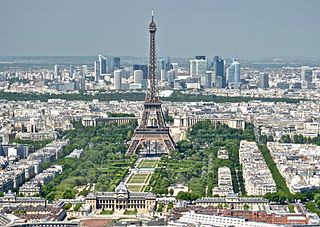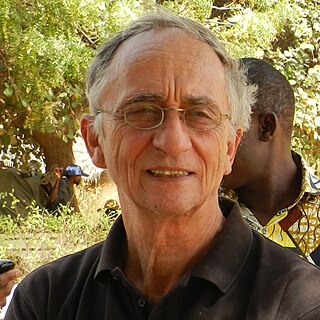Related Research Articles
Oulipo is a loose gathering of (mainly) French-speaking writers and mathematicians who seek to create works using constrained writing techniques. It was founded in 1960 by Raymond Queneau and François Le Lionnais. Other notable members have included novelists Georges Perec and Italo Calvino, poets Oskar Pastior and Jean Lescure, and poet/mathematician Jacques Roubaud.

Tourism in France directly contributed 79.8 billion euros to gross domestic product (GDP) in 2013, 30% of which comes from international visitors and 70% from domestic tourism spending. The total contribution of travel and tourism represents 9.7% of GDP and supports 2.9 million jobs in the country. Tourism contributes significantly to the balance of payments.

Claude Simon was a French novelist, and was awarded the 1985 Nobel Prize in Literature.

Picard is a langue d'oïl of the Romance language family spoken in the northernmost of France and parts of Hainaut province in Belgium. Administratively, this area is divided between the French Hauts-de-France region and the Belgian Wallonia along the border between both countries due to its traditional core being the districts of Tournai and Mons.

Henri Lefebvre was a French Marxist philosopher and sociologist, best known for pioneering the critique of everyday life, for introducing the concepts of the right to the city and the production of social space, and for his work on dialectical materialism, alienation, and criticism of Stalinism, existentialism, and structuralism. In his prolific career, Lefebvre wrote more than sixty books and three hundred articles. He founded or took part in the founding of several intellectual and academic journals such as Philosophies, La Revue Marxiste, Arguments, Socialisme ou Barbarie, Espaces et Sociétés.

Simha Arom is a French-Israeli ethnomusicologist who is recognized as a world expert on the music of central Africa, especially that of the Central African Republic. His books include African Polyphony and Polyrhythm: Musical Structure and Methodology (1991) ISBN 0-521-24160-X. He also made some historical field recordings of the Aka Pygmy music.

The Pont des Arts or Passerelle des Arts is a pedestrian bridge in Paris which crosses the River Seine. It links the Institut de France and the central square of the Palais du Louvre,.

The Île-de-France is the most populous of the eighteen regions of France, with an official estimated population of 12,271,794 residents on 1 January 2023. Centred on the capital Paris, it is located in the north-central part of the country and often called the Paris Region. Île-de-France is densely populated and retains a prime economic position on the national stage: though it covers only 12,012 square kilometres, about 2% of metropolitan French territory, its 2017 population was nearly one-fifth of the national total.

The Parc de la Villette is the third-largest park in Paris, 55.5 hectares in area, located at the northeastern edge of the city in the 19th arrondissement. The park houses one of the largest concentrations of cultural venues in Paris, including the Cité des Sciences et de l'Industrie, three major concert venues, and the prestigious Conservatoire de Paris.
Louis-Vincent Thomas was a French sociologist, anthropologist, ethnologist, and scholar whose specialty was Africa. He was the founder of thanatology. After having taught at Cheikh Anta Diop University, he became a sociology professor at Paris Descartes University.

Tourism in Paris is a major income source. Paris received 12.6 million visitors in 2020, measured by hotel stays, a drop of 73 percent from 2019, due to the COVID-19 pandemic. The number of foreign visitors declined by 80.7 percent. Museums re-opened in 2021, with limitations on the number of visitors at a time and a requirement that visitors wear masks.
Albert Piette is a French anthropologist. He is a professor at Paris Nanterre University.

Jean-Pierre Olivier de Sardan is a French and Nigerien anthropologist, and Emeritus Professor of Anthropology at the École des Hautes Études en Sciences Sociales in Marseilles. He is also Emeritus Director of Research at the Centre National de la Recherche Scientifique in Paris and associate professor at Abdou Moumouni University in Niamey where he founded the master of socio-anthropology of health.
Christ Walking on the Water is an 1899 French silent trick film directed by Georges Méliès.
Anti-urbanism is hostility toward the city as opposed to the country, a simple rejection of the city -- a wish to destroy the city. This hostility is not an individual sentiment, but a collective trope, sometimes evoked by the expression "urbophobia" or "urbanophobia" This trope can become politicized and thus influence spatial planning. Antiurbanism, while, of course, appearing within different cultures for different political purposes, is a global concept
Jean-Pierre Dupuy is a French engineer and philosopher.

Michel Houellebecq is a French writer and occasional actor, film director and singer.

Yves Winkin is a Belgian academic who spent much of his career based in France. He is known for work in communication, specifically for developing the anthropology of communication, for introducing the concept of enchantment to the social sciences, for investigating pedestrian behavior, and for his analyses of Erving Goffman's work in relation to his life. At various times, he worked with Pierre Bourdieu in France, as well as Goffman, Dell Hymes, and Ray Birdwhistell in the US, leading to his efforts to share research across international borders. In addition, he has held three kinds of administrative position.
According to Nazi theorists, denordification is the racial counterpart of the political decadence experienced by peoples throughout their history. The concept was coined by Nazi theorist Alfred Rosenberg, based on his analysis of the decadence of Rome and Ancient Greece.
Tourism in Brittany attracts around 13 million visitors a year. An important sector of the region's economy, it accounts for just under 10% of the region's GDP, and directly employs just under 70,000 people. Seasonal activity extends from May to September, and is mainly concentrated on the coast, particularly in the departments of Finistère and Morbihan.
References
- ↑ Gell, A. (1992). The technology of enchantment and the enchantment of technology. In J. Coote & A. Shelton (Eds.), Anthropology, art, and aesthetics (pp. 40–63). Oxford: Oxford University Press.
- ↑ Ritzer, G. (1999). Enchanting a disenchanted world: Revolutionizing the means of consumption. Thousand Oaks: Pine Forge Press.
- ↑ Richards, G. (2001). The experience industry and the creation of attractions. In G. Richards (Ed.), Cultural attractions and European tourism (pp. 55-70). Oxon, UK: CABI Publishing, p. 59.
- ↑ Winkin, Y. (2001). Propositions pour une anthropologie de l'enchantement. In P. Rasse, N. Midol, & F. Triki (Eds), Unité-diversité: Les identités culturelles dans le jeu de la mondialisation (pp. 169-179). Paris: L'Harmattan.
- ↑ Winkin, Y. (1998). Le touriste et son double: Éléments pour une anthropologie de l’enchantement. In S. Ossman (Ed.), Miroirs maghrébins: Itinéraires de soi et paysages de rencontre (pp. 133-134). Paris: CNRS éditions.
- ↑ Winkin, Y. (2001). Anthropologie de la communication – de la théorie au terrain. Paris: Le Seuil, pp. 215-216.
- ↑ Winkin, Y. (2005). Communiquer a Cerisy. In E. Heurgon, et al. (Eds), Cent ans de rencontres intellectuelles de Pontigny à Cerisy (pp. 287-305). Paris: Editions de l'IMEC.
- ↑ Bertrand Réau, F. P. (2007). L'enchantement du monde touristique. Actes de la recherche en sciences sociales, 5 (170), 4-13. DOI 10.3917/arss.170.0004
- ↑ Stock, M. (2021). Progress in French Tourism Geographies: Inhabiting Touristic Worlds. London: Springer Link.
- ↑ De Bideran, J. (2021). Digitization and staging of literary heritage in authors’ homes: The virtual visit of the Centre François Mauriac in Malagar. Culture et Musées, (38), 149-174.
- ↑ Lovell, J., & Griffin, H. (2022). Unfamiliar light: The production of enchantment. Annals of Tourism Research, 92, 103328. https://doi.org/10.1016/j.annals.2021.103328
- ↑ Winkin, Y. (2005). Le Chemin de St Jacques comme performance enchantée. In M. Alizer & C. Kihm (Eds.), Fresh theory. Paris: Leo Scheer.
- ↑ Lavadinho, S., & Winkin, Y. (2012). Vers une marche plaisir en ville: boîte à outils pour augmenter le bonheur de marcher. Lyon, France: Editions du CERTU (Centre d’Etudes sur les Réseaux, les Transports et l’Urbanisme).
- ↑ Lavadinho, S., & Winkin, Y. (2008). Enchantment engineering and pedestrian empowerment: The Geneva case. In T. Ingold & J. L. Vergunst (Eds.), Ways of Walking: Ethnography and practice on foot (pp. 155-167). Aldershot, UK: Ashgate. https://doi.org/10.4324/9781315234250
- ↑ Lavadinho, S.; Lebrun-Cordier, P.; Winkin, Y. (2022). La ville relationnelle. Bfluid Publishing.
- ↑ de Neergaard, M., & Jensen, H. L. (2020). Embodied ethnography in mobilities research. In M. Büscher, M. Freudendal-Pedersen, S. Kesselring, N. G. Kristensen (Eds.), Handbook of research methods and applications for mobilities (pp. 374-381). Cheltenham, UK: Edward Elgar Publishing.
- ↑ Brahy, R., & Pattaroni, L. (2023). Commoning the touristic city: Urban pedestrian routes and the ambiguous politics of exploration. In I. Sánchez-Fuarros, D. Paiva, & D. Malet Calvo (Eds.), Ambiance, tourism and the city (pp. 113-136). London: Routledge.
- ↑ "L'Enchantement qui revient; Centre Culturel International de Cerisy".
- ↑ Brahy, R., Thibaud, J.-P., Tixier, N., & Zaccaï-Reyners, N. (Eds.). (2023). L’enchantement qui revient. Paris: Hermann.
- ↑ Dell'Aria, A. (2021). The moving image as public art: Sidewalk spectators and modes of enchantment. Palgrave Macmillan, p. 5 and p. 9.